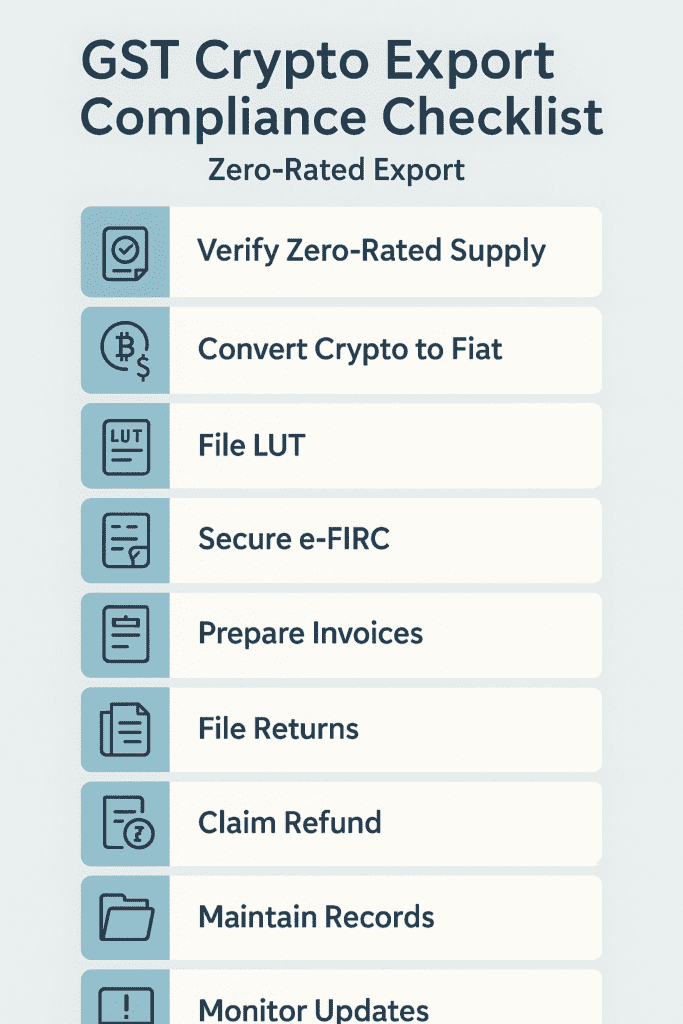
Introduction
GST crypto export compliance checklist helps exporters confirm zero-rated eligibility, even when accepting virtual digital assets. Therefore, you must convert crypto into convertible foreign exchange and secure proof to benefit from zero-rated exports. This guide walks you through all critical steps, so you file accurately and claim your refunds smoothly.
Verify Zero-Rated Supply Conditions
- IGST Act § 2(6) Definition: “Export of services” must meet these:
- Supplier in India.
- Recipient outside India.
- Place of supply outside India.
- Payment received in convertible foreign exchange.
- Supplier & recipient are distinct persons
- Zero-Rated Supply: Exports under GST are “zero-rated” (0% tax) if conditions are met
Convert Crypto to Fiat
- Crypto Non-Recognition: RBI/FEMA do not recognize cryptocurrency as foreign exchange; banks can’t issue FIRC on crypto
- Active Step: Route virtual asset receipts through a regulated exchange or AD bank. Then convert into INR/foreign currency
File Letter of Undertaking (LUT)
- Why LUT? LUT exempts exporters from paying IGST upfront, letting them claim refunds directly
- How to File: Submit Form RFD-11 before the financial year’s first export
- Retention: Keep LUT acknowledgments for audits.
Secure e-FIRC
- Deposit Proceeds: After converting crypto, deposit funds with an AD bank.
- Obtain e-FIRC: Request electronic FIRC for each export transaction as proof of foreign exchange realization
Prepare and Issue Compliant Invoices
- Invoice Requirements:
- Mention “Zero-Rated Supply.”
- Include foreign currency value and LUT reference.
- Use correct SAC codes and invoice numbering
- Organization: Maintain invoice copies and correspondence chronologically.
File GST Returns Accurately
- GSTR-1: Report export invoices under Table 6B monthly/quarterly
- GSTR-3B: File without IGST payment if operating under LUT route
Claim Refunds
- Form RFD-01: File refund application for unutilized ITC (LUT) or IGST paid (bond route)
- Follow-Up: Monitor portal status and respond to queries promptly.
Maintain Records & Audit Trail
- Essential Documents:
- LUT and acknowledgments.
- e-FIRC copies.
- Crypto-to-fiat transaction statements.
- GST returns and refund correspondence
- Organization: Use folders or digital filing systems for easy retrieval.
Monitor Regulatory Updates
- CBIC Notifications: Follow CBIC circulars for GST export changes
- RBI/FEMA: Track RBI notifications on virtual currencies and FEMA provisions.
- Subscriptions: Subscribe to official newsletters (gstcouncil.gov.in, rbi.org.in).
Conclusion
A robust GST crypto export compliance checklist ensures you leverage zero-rated benefits and avoid notices. Follow these nine steps—verify eligibility, convert crypto, file LUT, secure e-FIRC, prepare invoices, file returns, claim refunds, maintain records, and monitor updates—to stay audit-ready and cash-efficient.
✅ Download our FREE “GST Crypto Export Compliance Toolkit” now to access templates, sample invoices, and an LUT filing guide.
Stuck somewhere?
Disturb us to help you out!
Harshaditya Kabra
+91-88277-53530
https://www.linkedin.com/in/ca-harshaditya/
https://accorgconsulting.com/
